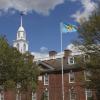Research center examines health of Delaware waters
Is the growth of baby horseshoe crabs affected by pesticides and birth control hormones that find their way into local waterways? What about the birds that eat horseshoe crab eggs?
Those are questions researchers at Stroud Water Research Center are hoping to answer.
The Pennsylvania-based nonprofit traveled to Dogfish Head Craft Brewery in southern Delaware Aug. 20 to share information about Delaware-based water-quality research projects, including one that examines how endocrine-disrupting chemicals affect horseshoe crab larvae.
The horseshoe crab project, spearheaded by former University of Delaware graduate student Emily Maung-Douglass, is among seven recent projects researching the health of Delaware's waterways.
Maung-Douglass spent about five years examining horseshoe crab eggs and larvae from the Inland Bays to determine concentrations of chemicals such as pesticides, birth control hormones and compounds found in hand soap.
“Whether it's hand soap or something to help reduce mosquito populations, they're definitely parts of our modern-day society that we can't imagine living without, but they do end up back in the environment,” she said. “We have to consider how they might impact our local wildlife populations.”
Maung-Douglass, who has not yet published her findings, said she hopes her research will encourage people to keep in mind the important role species like the horseshoe crab play ecologically and as an important tool in medical vaccine testing.
“The nice thing about the horseshoe crab is it's kind of an iconic species,” said Stroud Director and senior research scientist Bern Sweeney. Sweeney said there has been a lot of research on how endocrine-disruptors, such as birth control pills, cause changes in the reproductive activity of fish, insects and other species, and researchers have detected these compounds in grown horseshoe crabs. Maung-Douglass’s research was funded by a DuPont Clear into the Future fellowship.
Sweeney said the key is not only researching how various chemical compounds affect horseshoe crabs, but figuring out the concentration levels of pesticides or hormones found in eggs to see if those compounds could affect birds, like the red knot, or other animals that rely on horseshoe crab eggs for food.
“What happens is you start looking at concentrations and effects in one animal, then another, and then some kind of pattern emerges,” he said. “Then you can move forward in changing legislation or impacting public perception.”
In Bethany Beach, the Stroud Center has developed a new technology to wirelessly transmit water-quality data from backwater lagoons at a manageable cost. For less than $1,000, the center designed a solar-powered device that allows Delaware Center for the Inland Bays to review real-time water-quality data - equipment that would normally cost $5,000 to $10,000, Sweeney said.
“That's the reason conservation groups have not been using them extensively,” he said. The project was funded by the National Science Foundation, and the center is preparing to install another 75 to 100 transmitters around the Delaware River watershed.
“There will not be more clean water if people don't buy in,” said John Jackson, an entomologist and senior research scientist at the center. “Our approach has always been to start local.”
Additional Stroud Center projects in the First State include investigative research that paved the way for a successful Delaware Department of Justice case that found a landowner who filled in a small wetland in Smyrna violated the Clean Water Act; and research that found the Kent County Wastewater Treatment Plant was not adversely affecting water quality of the Murderkill River estuary.
The Stroud Center, established in 1967 and located 20 miles outside Wilmington, operates with a staff of 40 to 70 people and is funded primarily through state and federal grants, competitive grants and also conducts privately funded projects. For more information, go to www.stroudcenter.org.





















































